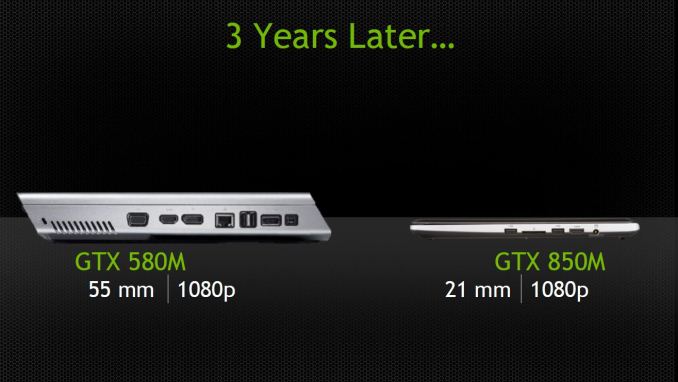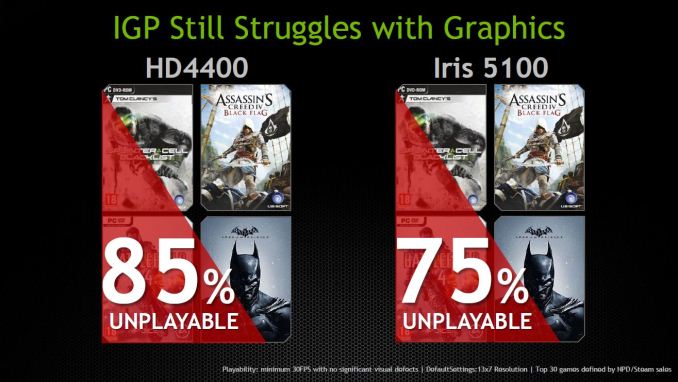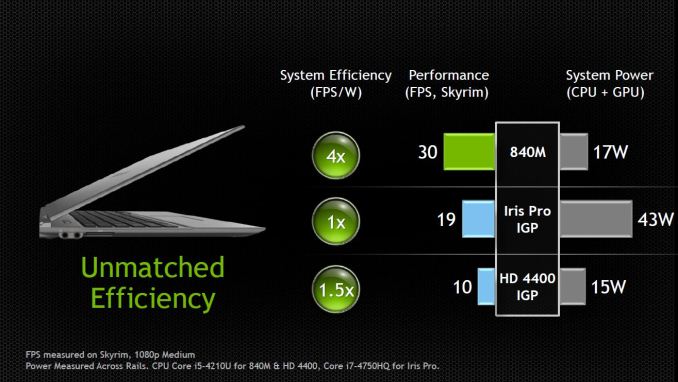NVIDIA’s GeForce 800M Lineup for Laptops and Battery Boost
by Jarred Walton on March 12, 2014 12:00 PM ESTGaming Notebooks Are Thriving
Wrapping things up, I’ll include a gallery of NVIDIA’s slides at the end, but let’s quickly go over a few interesting items. NVIDIA provided some research showing that PC gaming is an extremely large industry – competing in yearly revenue with the likes of movie theater ticket sales, music, and DVD/Blu-ray video sales. Along with that growth, growth in the gaming notebooks market has been significant over the past three years, and even greater growth is expected for 2014. A large part of that is no doubt thanks to Optimus, as it allows potentially any notebook to deliver good gaming performance when you need it while not absolutely killing battery life when you don’t need the GPU. The other aspect is that we are simply seeing more GTX class notebooks shipping, thanks to GPUs like the GTX 760M/765M, and with the 850M now moving into the GTX class (which is where NVIDIA draws the line for “gaming notebooks”) we’ll see even more. But it’s not just about names; the following slide is a great illustration of what we’ve seen since 2011:
It’s not too hard to guess what the notebook on the left is (hello Alienware M17x R3), while on the right it looks like Gigabyte’s P34G. That’s not really important, but the difference in size is pretty incredible, and what’s more, the laptop on the right s actually 30% faster with GTX 850M than the GTX 580M from 2011. It also happens to deliver better battery life – gaming or otherwise. Leaner, lighter, and faster are all good things for gaming notebooks. As you would expect, there are quite a few GTX 800M notebooks coming out soon or in the very near future (while most other 800M parts will mostly come a bit later). NVIDIA provided the following images along with some other information on upcoming laptops, so if you’re in the market keep an eye out for the following (in alphabetical order).
The Alienware 17 will be updated to support both the GTX 870M and GTX 880M. ASUS’ G750JZ will update the G750JH and move from GTX 780M to GTX 880M (and apparently Optimus will be enabled this round). Gigabyte will have new versions of the P34G, the P34R with 860M and the P34J with 850M, an updated P35R (P35K core design) with 860M, and apparently updates to the P25 and P27 as well (likely with mainstream 800M class GPUs, so specifics haven’t been given yet). Lenovo’s Y50 will be their now gaming notebook, with a single GTX 860M and an optional high-DPI display. MSI will also be updating their GT70, GT60, GS70, and GS60; the GT models will support GTX 880M and 870M while the GS models will support the GTX 870M and 860M. And finally (though I suspect we’ll see Clevo, Toshiba, and Samsung announce products with GTX 800M GPUs at some point, along with perhaps some other OEMs as well), Razer Blade will have a new 14” Blade with GTX 870M and a 17” Blade Pro with GTX 860M – and no, that’s not a typo, though perhaps we’ll see more than one model of Blade Pro as it seems odd for the smaller laptop to support a faster GPU.
Finally, on the topic of the need for discrete GPUs in laptops, NVIDIA noted that over 85% of the top 30 games (according to NPD/Steam sales) remain unplayable with Intel’s HD 4400 (no surprise, as that’s basically the same performance as HD 4000), while 75% still remain unplayable with Iris 5100 – this is using 1366x768 resolution with “default settings” (presumably medium, but it’s not specifically stated). What’s missing is information on what’s playable with Iris Pro, but while I can say that most games I’ve tested on Iris Pro are able to break 30FPS average frame rates, ironically power use on the i7-4750HQ laptop I’ve tested is actually worse when gaming than most laptops with GT class 700M GPUs. NVIDIA shows this in their results as well, and while I can’t verify the numbers they claim to provide better performance with a 840M than Iris Pro 5200 while using less than half as much power.
Intel has certainly improved their iGPU performance with the last several processor generations, but unfortunately the higher performance has often come only when given more power – so for example a GT2 or GT3 Haswell part limited to 15W total TDP (i.e. in an Ultrabook) is typically no better than a GT2 Ivy Bridge part with a 17W TDP. Broadwell will likely bring us a “GT4” part (to go along with GT3e), but we’ll have to see if Intel is able to improve performance within the same power envelope when those parts start shipping later this year.

















_thumb.jpg)



















91 Comments
View All Comments
Connoisseur - Wednesday, March 12, 2014 - link
Jarred. In regards to the ultra high-res displays, have you already or do you plan on putting together an article regarding gaming and upscaling on 3K and 4K screens? More and more laptops are coming out with these "retina" style displays where the graphics card won't be able to run games at native res. I'd like to see how the games would look/perform with upscaling. For example, running the game at 16x9 or 1080p with various settings on a 3k screen.I think it'd be an important article because it would affect my buying choice when offered multiple screen options with the same laptop.
JarredWalton - Wednesday, March 12, 2014 - link
I commented on this in the Dell XPS 15 review. Basically, upscaling (or running at non-native) is much less noticeable in many respects as the pixels are so small. The other side of the coin is that there are way too many Windows apps that I use that don't work well with high DPI. In a few years, I think it will all get sorted out, but right now high DPI is "bleeding edge" stuff.rxzlmn - Thursday, March 13, 2014 - link
4K is much better than 3K though, due to the fact that you can natively scale to both 720p and 1080p.Dustin Sklavos - Wednesday, March 12, 2014 - link
I wonder if Vivek had a hand in that. ;)JarredWalton - Wednesday, March 12, 2014 - link
Possibly, but I thought he was primarily concerned with making the chassis and waxing eloquent on the joys of the material choices and such. Speaking of which, what are you working on these days? Hahaha....WinterCharm - Wednesday, March 12, 2014 - link
Just checked out Razer's website...That blade has an IGZO (Indium Gallium Zinc Oxide) IPS touchscreen, at a resolution of 3200x1800.
Looks like you're in luck! :) just... uh... prepare your wallet.
Connoisseur - Thursday, March 13, 2014 - link
Wallet is never prepared. I just club it on the head and drag it out. This will be one hell of an expensive purchase if I end up buying it. I'm really curious about the heat and noise generated by this beast. Looks like it's shipping in April? I'm hoping AT gets a review sample.talos113 - Wednesday, March 12, 2014 - link
This is great news! I look forward to seeing laptops become thinner and more powerful. I know they will never fully reach desktop performance, but it makes me smile seeing them gain. I recently purchased a sager np9150 with a 7970m and I am honestly using my desktop less and less while I enjoy the benefits of mobility. Its an awesome time for technology!warezme - Wednesday, March 12, 2014 - link
I'm still rocking a big Alienware 17x R3 with 580M so I have been eyeing the upgrade paths. But, I can't help but be very disappointed the "880M" is not Maxwell technology but just re-branded old stuff. I don't care if its 20% faster. I don't mind a carrying around a large laptop. I'm not a frail girl.JarredWalton - Wednesday, March 12, 2014 - link
My guess is we'll see Maxwell GTX 890M or 885M or something during the summer months -- just in time for the back-to-school shopping.